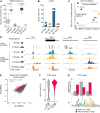The impact of the embryonic DNA methylation program on CTCF-mediated genome regulation
- PMID: 39180406
- PMCID: PMC11472158
- DOI: 10.1093/nar/gkae724
The impact of the embryonic DNA methylation program on CTCF-mediated genome regulation
Abstract
During mammalian embryogenesis, both the 5-cytosine DNA methylation (5meC) landscape and three dimensional (3D) chromatin architecture are profoundly remodeled during a process known as 'epigenetic reprogramming.' An understudied aspect of epigenetic reprogramming is how the 5meC flux, per se, affects the 3D genome. This is pertinent given the 5meC-sensitivity of DNA binding for a key regulator of chromosome folding: CTCF. We profiled the CTCF binding landscape using a mouse embryonic stem cell (ESC) differentiation protocol that models embryonic 5meC dynamics. Mouse ESCs lacking DNA methylation machinery are able to exit naive pluripotency, thus allowing for dissection of subtle effects of CTCF on gene expression. We performed CTCF HiChIP in both wild-type and mutant conditions to assess gained CTCF-CTCF contacts in the absence of 5meC. We performed H3K27ac HiChIP to determine the impact that ectopic CTCF binding has on cis-regulatory contacts. Using 5meC epigenome editing, we demonstrated that the methyl-mark is able to impair CTCF binding at select loci. Finally, a detailed dissection of the imprinted Zdbf2 locus showed how 5meC-antagonism of CTCF allows for proper gene regulation during differentiation. This work provides a comprehensive overview of how 5meC impacts the 3D genome in a relevant model for early embryonic events.
© The Author(s) 2024. Published by Oxford University Press on behalf of Nucleic Acids Research.
Figures






References
-
- Greenberg M.V.C., Bourc’his D.. The diverse roles of DNA methylation in mammalian development and disease. Nat. Rev. Mol. Cell Biol. 2019; 20:590–607. - PubMed
MeSH terms
Substances
Grants and funding
LinkOut - more resources
Full Text Sources
Molecular Biology Databases

